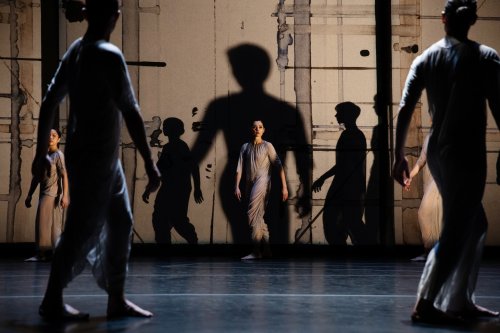Four Quartets
A major modern dance work tied to the poetry of T.S. Eliot.

A scene from Pam Tamowitz’s ballet “Four Quartets,” to the text by T.S. Eliot, at BAM Howard Gilman Opera House (Photo credit: Julieta Cervantes)
[avatar user=”Joel Benjamin” size=”96″ align=”left”] Joel Benjamin, Critic[/avatar]
There’s a long history of modern dance choreographers composing works supported by the spoken word. Martha Graham did it and so did Merce Cunningham. Now Pam Tamowitz has brought her troupe of excellent dancers to the Brooklyn Academy of Music in her much lauded work Four Quartets which debuted in 2018 at the Fisher Center at Bard College.
The Four Quartets are, of course, the master poems (written between 1936 and 1942, published in 1943) by American ex-pat T. S. Eliot, poems filled with images of despair and the relentlessness of existence (“In my beginning is my end,” East Coker). Veteran actor Kathleen Chalfant pronounced the poetry with a somberness only infrequently interrupted by unexpected ironic humor in the text. Long periods of dance were performed without Chalfant’s speaking the words.
In her selection of the movements and structure of Four Quartets, Tamowitz chose to ignore the depth and imagery of the poems, producing a cool Merce Cunningham-like ballet that glided along beautifully on the surface of Eliot’s heavy, sometimes distasteful, imagery. Movements were balletic, full of arabesques, skittery connecting steps, soft leaps and jumps.
She built the work upon a series of steps and phrases that are repeated in various ways: jumped, turned, performed alone, performed in unison and performed in reverse. One salient image was that of a dancer jumping into the arms of another. Other than that there was very little touching. The barefoot dancers often mimicked each other or performed side by side. Only two duets occurred, one quite long near the end, watched by the other cast members gathered at the corners of the set.
Four Quartets began as the lights came up behind the beautiful front curtain revealing a single dancer in a spotlight, at first still, then moving her legs and arms in soft circles, her foot tapping the ground, her hands leading her arms up and around in soft circles. After a long while she was replaced by another dancer and then by two as the work built some momentum. They all wore gossamer costumes, in pale green and white, designed by Reid Bartelme and Harriet Jung.

A scene from Pam Tamowitz’s ballet “Four Quartets,” with reader Kathleen Chafant and musicians The Knights at BAM Howard Gilman Opera House (Photo credit: Julieta Cervantes)
The divisions of the ballet were more noted by the changes in Clifton Taylor’s sensational scenic and lighting design, particularly the latter when, towards the end of the work, he made the small company appear to multiply into many smoothly moving beings, their multiple shadows cast on the back wall of the Gilman Auditorium stage. Taylor’s scenic efforts were inspired by the images of Brice Marden.
At one point, several large, vertically striped panels dropped down. The center panel provided a hiding place for dancers who ran behind it. Repeatedly, a dancer would race behind this colorful wall only to reappear seconds later, a theme that became more and more annoying than expressive.
The aforementioned impressive front scrim was a horizontally divided design, totally brilliant red on top and a jungle of what appeared to be red trunks of trees on a yellow background below. This simple but masterful design promised much more than was delivered by the choreography.
Is it fair to wonder if it was the famous poem, as fascinatingly read by the fantastic actor Kathleen Chalfant, gave artistic weight to the bland, repetitive choreography? Certainly Kaija Saariaho’s moody score, played by The Knights, helped elicit all sorts of moods not reflected in the steps.
The nine dancers were all splendid and clearly of one artistic mind, obviously that of Tamowitz.
Four Quartets (February 10 – 12, 2022)
Pam Tamowitz Dance
Brooklyn Academy of Music
BAM Howard Gilman Opera House, 30 Lafayette Avenue, in Brooklyn
For tickets, call 718-636-4100 or visit http://www.BAM.org
Running time: 75 minutes without an intermission






Leave a comment